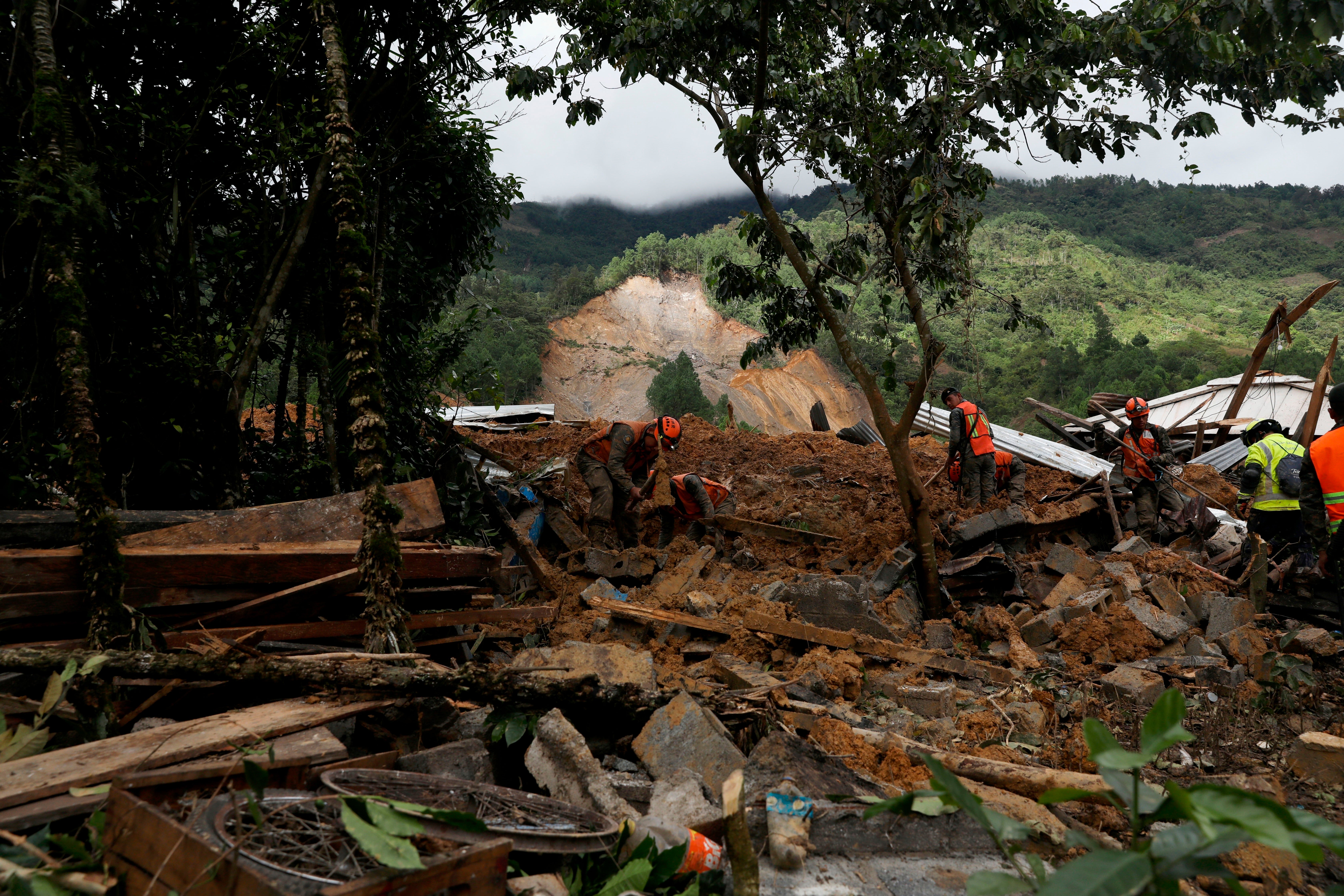Eta zeroes in on Cuba, as Guatemala searches for victims
A strengthened Tropical Storm Eta churned toward Cuba and then set its sights on the southern tip of Florida, already inundated by heavy rains and unusual King Tides

Your support helps us to tell the story
From reproductive rights to climate change to Big Tech, The Independent is on the ground when the story is developing. Whether it's investigating the financials of Elon Musk's pro-Trump PAC or producing our latest documentary, 'The A Word', which shines a light on the American women fighting for reproductive rights, we know how important it is to parse out the facts from the messaging.
At such a critical moment in US history, we need reporters on the ground. Your donation allows us to keep sending journalists to speak to both sides of the story.
The Independent is trusted by Americans across the entire political spectrum. And unlike many other quality news outlets, we choose not to lock Americans out of our reporting and analysis with paywalls. We believe quality journalism should be available to everyone, paid for by those who can afford it.
Your support makes all the difference.A strengthened Tropical Storm Eta churned toward Cuba and the southern tip of Florida after leaving dozens dead and over 100 missing in Central America which it hit earlier in the week as a major hurricane.
Cuba braced for Eta even as searchers in Guatemala were still digging for people believed buried by a massive, rain-fueled landslide. Authorities say 15 people are confirmed dead and at least 109 are missing in Guatemala, many of them in the landslide in San Cristobal Verapaz.
The U.S. National Hurricane Center issued tropical storm warnings for southern Florida and the Florida Keys, and warnings were issued for central Cuba; parts of southern Florida and the Keys were even put under a hurricane watch.
The Hurricane Center said Eta was located about 140 miles (220 kilometers) west-southwest of Camaguey, Cuba, Saturday and was moving northeast at 13 mph (20 kph) with winds of 65 mph (100 kph). The storm was expected to hit Cuba by early Sunday, and approach the Florida Keys and south Florida late Sunday or Monday.
Florida Gov. Ron DeSantis declared a state of emergency Saturday for eight counties at the end of the state as Eta approached, urging residents to stock up on supplies. South Florida started emptying ports and a small number of shelters opened in Miami and the Florida Keys for residents in mobile homes and low lying areas.
Miami Dade County declared a state of emergency Friday night and also warned a flood watch would be in effect through Tuesday night.
Further south in the Keys, officials were monitoring the storm closely, but had no plans yet to evacuate tourists or residents. They urged residents to secure their boats and encouraged visitors to consider altering plans until Eta had passed.
“Residents need to monitor this storm and be prepared for high tropical storm force sustained winds and hurricane strength gusts,” said Shannon Wiener, Monroe County Emergency Management Director.
Eta was once a Category 4 hurricane, and authorities from Panama to Mexico were still surveying the damages following days of torrential rains during the week.
In Guatemala, search teams first had to overcome multiple landslides and deep mud just to reach the site where officials have estimated some 150 homes were devastated.
In the worst-hit village, Quejá, at least five bodies have been pulled from the mud. The Indigenous community of about 1,200 residents consisted of simple homes of wood and tin roofs clinging to the mountainside
Rescue workers used a helicopter to evacuate survivor Emilio Caal, who said he lost as many as 40 family members and relatives. Caal, 65, suffered a dislocated shoulder when the landslide sent rocks, trees and earth hurtling onto the home where he was about to sit down to lunch with his wife and grandchildren. Caal said he was blown several yards (meters) by the force of the slide, and that none of the others were able to get out.
“My wife is dead, my grandchildren are dead,” said Caal from a nearby hospital.
In neighboring Honduras, 68-year-old María Elena Mejía Guadron died when the brown waters of the Chamelecon river poured into San Pedro Sula’s Planeta neighborhood before dawn Thursday.
Mirian Esperanza Nájera Mejía had fled her home in the dark with her two children and Mejía, her mother. But while she held tight to her children, the current swept away Mejía.
Nájera searched desperately for her mother Friday morning. But Mejía’s body was later recovered.
“When the flooding started, the whole family was leaving the house,” said family friend Nery Solis. “Mirian had her two children and suddenly the current grabbed them and she wasn’t able to get her mom.”
In southern Mexico, across the border from Guatemala, 20 people died as heavy rains attributed to Eta caused mudslides and swelled streams and rivers, according to Chiapas state civil defense official Elías Morales Rodríguez.
The worst incident in Mexico occurred in the mountain township of Chenalho, where 10 people were swept away by a rain-swollen stream; their bodies were later found downstream.
Flooding in the neighboring state of Tabasco was so bad that President Andrés Manuel López Obrador cut short a trip to western Mexico and was flying to Tabasco, his home state, to oversee relief efforts.
Hurricane Eta’s arrival in northeast Nicaragua Tuesday followed days of drenching rain as it crawled toward shore. Its slow, meandering path north through Honduras pushed rivers over their banks.
___
Associated Press writer Marlon González in Tegucigalpa, Honduras contributed to this report.